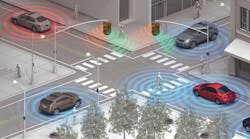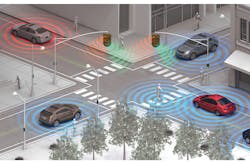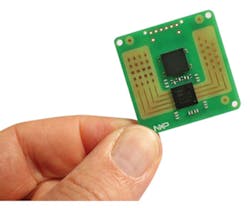This file type includes high resolution graphics and schematics when applicable.
Automobiles are being made smarter with each model year. Electronic technologies are playing major roles in enhancing vehicular safety, and that trend will continue. Cameras and millimeter-wave radar systems in newer car models, for example, can detect objects in front and rear and send warning and trigger signals to other subsystems within a car, such as the automatic braking system (ABS), to prevent an accident.
The interest of automotive manufacturers in producing fully autonomous vehicles has been well publicized, and the overall growth of electronic content within new-model automobiles represents a heartily growing market for electronic devices such as microprocessors and wireless transceivers, as well as software that can help build the road to the “driverless” vehicle of the future. But before we can all take our hands off the wheel, a better understanding of the industry’s growing electronic needs is needed.
Cars are smarter due to their growing electronics content, starting with their computer networks—among them, those based on the controller area network (CAN), local interconnect network (LIN), and FlexRay protocols. The CAN protocol, for example, allows all electronic devices in an automobile to communicate. A vehicle’s electronic control unit (ECU) can communicate by means of a single CAN interface, as opposed to utilizing separate analog and digital interfaces for different electronic components to save weight and complexity. The CAN protocol was first developed for automotive applications, but has been adopted by other industries (e.g., medical electronic equipment manufacturers) because of its reliability and effectiveness.
As vehicles gain more electronic content, an efficient communications and control protocol such as CAN is essential for orchestrating the sequences of messages among the networked devices. All devices on a CAN system first receive all transmitted messages from the ECU, then decide whether a message is relevant or should be filtered. Every message has a priority, and the device node with the higher priority has the opportunity to respond first. A CAN system includes cyclic redundancy code (CRC) that is used for error checking.
In addition to this communication of electronic devices within a vehicle’s own network, future vehicles will also communicate with each other by means of wireless vehicle-to -vehicle (V2V) communications. A recent proposal by the U.S. Department of Transportation (DoT) outlined the benefits of V2V communications and a timeframe for its implementation in new model cars (by 2023). The proposal is under review by a number of other organizations, including the U.S. Federal Highway Administration and the Alliance of Automobile Manufacturers.
By having all vehicles communicating their locations, speeds, directions, and other parameters 10 times per second to other vehicles, all vehicles will have a 360-deg. situational awareness of the traffic volume and conditions around them (Fig. 1), both to avoid accidents and minimize traffic congestion. Existing vehicular electronic technologies, such as collision-avoidance systems, are seen as complementary to V2V systems and networks.
The DoT’s proposal suggests that V2V technology can provide significant decreases in the number of accidents and significant decreases in the number of lives lost due to vehicular accidents. The 392-page proposal is aligned with the automotive industry’s efforts to develop autonomous, “self-driving” vehicles that would employ GPS satellite receivers for position information and V2V networks for cars to “talk” to each other by means of various electronic components and devices. As a consequence, roads are made safer even with less local control exerted by human drivers.
Wireless communications within a single vehicle has traditionally been conducted within the Industrial-Scientific-Medical (ISM) frequency band, typically from 315 to 915 MHz, although much higher frequencies are used for automotive radar systems and will be used for V2V technology. For example, in the U.S., the FCC has allocated the frequency range normally associated with wireless local area network (WLAN) equipment for V2V applications: 5.850 to 5.925 GHz. While internet providers and other wireless users are hoping to gain the use of some of this bandwidth, the automotive industry is well aware of the need for bandwidth if it is to achieve the challenging goals set for future V2V networks.
Depending upon geographic regions, the V2V standards and frequencies will vary. The U.S. V2V standard is commonly known as the wireless access for vehicular environments (WAVE) standard. Europe has the vehicular ad hoc network (VANET) standard, which is a variation on the mobile ad hoc network (MANET) standard. While the FCC that governs frequency bandwidth in the U.S., it is the European Telecommunications Standards Institute (ETSI) in Europe that sets the requirements for V2V technology. The latter governing body has created a standard known as ITS-G5, which is based on the IEEE’s 802.11p wireless networking standard.
Driving More Chips
Semiconductor manufacturers have been long at work developing and supplying wireless transceivers, sensors, and other forms of integrated circuits (ICs) for automotive electronics prior to the coming of V2V technologies. The list of well-established IC suppliers for automotive electronics is long, and includes Analog Devices, Broadcom, NXP Semiconductors, and Infineon Technologies. Not only are electronic sensors helping to meet stricter emissions standards for vehicles with internal combustion engines, but they are also being used to achieve low-emissions power trains in hybrid electric vehicles (HEVs).
The operating environment for automotive ICs is not unlike the specifications set for military electronic devices, with high reliability required over wide operating temperature ranges. To be considered “automotive-grade” electronic devices, such ICs must endure stress testing according to guidelines established by the Automotive Electronics Council (AEC) in the AEC Q100 specifications. Electronic devices for automotive use are qualified according to how rigorous the conditions of their particular applications and locations within the vehicle, with grades 0 through 4 assigned for different ambient operating temperature ranges: −40 to +150°C (Grade 0), −40 to +125°C (Grade 1), −40 to +105°C (Grade 2), −40 to +85°C (Grade 3), and −40 to +70°C (Grade 4).
Through its merger with Freescale Semiconductor, NXP (which is in turn about to be acquired by Qualcomm) fortified its already strong semiconductor design and fabrication capabilities to produce some of the industry’s smallest 77-GHz radar ICs (Fig. 2). Based on a high-frequency silicon germanium (SiGe) semiconductor process, the single-chip, multiple-channel, 77-GHz radar transceiver measures just 7.5 × 7.5 mm2 and provides high-resolution radar performance for automotive advanced driver assistance systems (ADASs). The small size of the radar IC makes it easier to integrate into multiple locations within a vehicle. The IC provides the accurate, high-resolution radar returns needed for self-driving autonomous vehicles in addition to its support of collision-avoidance systems and adaptive cruise control systems.
Infineon, a long-time supplier of automotive electronic solutions, also relies on a SiGe semiconductor process for its radar system IC (RASIC) series of 77-GHz automotive radar devices that are fully qualified to AEC-Q100 requirements. The highly integrated devices require few, if any, additional external components.
NXP, which supports all three automotive network protocols, also makes a number of RF-based solutions for automotive electronics applications at ISM band frequencies, including a single-chip transceiver with programmable fractional-N phased-lock loop (PLL) frequency synthesizer. These lower-frequency devices are typically used for such applications as communicating data from tire pressure monitoring systems (TPMSs) and for keyless remote entry and other telemetry applications. The firm supplies a range of sensors for such functions as monitoring gas emissions and fluid temperature monitoring (such as for antifreeze and motor oil).
All automotive radar systems are not at millimeter-wave frequencies, as Analog Devices offers a frequency-modulated-continuous-wave (FMCW) radar chip for use at 24 GHz, along with a number of different sensors based on MEMS technology. The radar chipset includes a two-channel transmitter, a four-channel receiver, and a 13-GHz fractional-N PLL frequency synthesizer. The firm recently bolstered its position as an electronics component supplier for automotive safety systems by acquiring solid-state laser-beam steering technology from the privately held Vescent Photonics, Inc. of Golden, Colo. The nonmechanical technology is a good fit for automotive LIDAR systems with higher reliability than mechanical solutions.
Between the self-contained networks within each vehicle, such as a CAN system, and the expectations of widespread V2V wireless communications capabilities in future vehicles, modern wireless communications technologies will ensure that vehicles are as well connected as their owners. Whether a driver’s hands are on or off the steering wheel, hopefully the end result is a safer driving experience for all.
This file type includes high resolution graphics and schematics when applicable.




